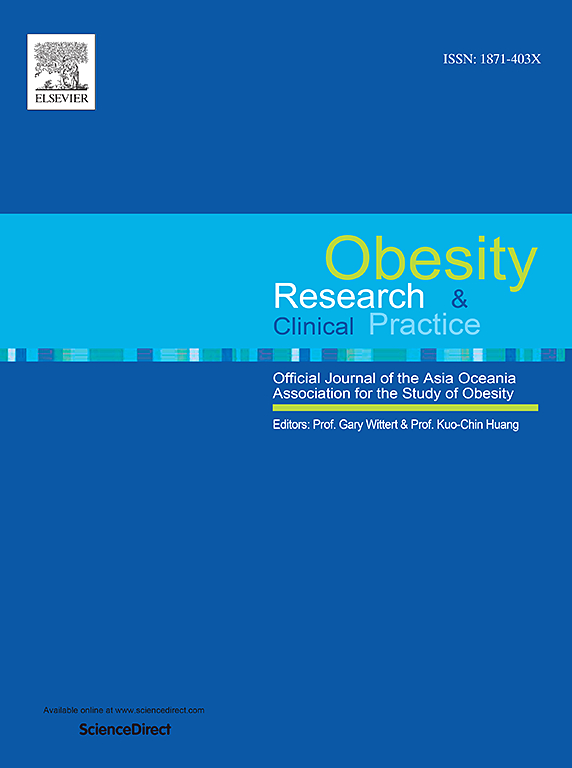Association between waist-to-height ratio and headache symptoms in U.S. youth: A nationwide cross-sectional study
IF 2.5
4区 医学
Q3 ENDOCRINOLOGY & METABOLISM
引用次数: 0
Abstract
Objective
To examine the association between waist-to-height ratio (WHtR), a marker of central adiposity, and the odds of frequent or severe headaches, including migraines, in U.S. children and adolescents.
Methods
We analyzed 8915 participants aged 8–19 years in the 1999–2004 National Health and Nutrition Examination Survey (NHANES). WHtR was calculated as waist circumference divided by height and scaled by 10 to reflect the effect of a 0.1-unit increase. We applied survey-weighted logistic regression models to estimate associations between WHtR and self-reported headache status, adjusting for demographic, metabolic, and behavioral covariates. Additional interaction and sensitivity analyses were conducted to assess effect modification and robustness.
Results
Each 0.1-unit increase in WHtR was associated with a 26 % higher odds of reporting headaches (OR = 1.26, 95 % CI: 1.15, 1.38; p < 0.001). Compared to the lowest quartile (Q1), participants in the highest quartile (Q4) had 34 % greater odds (OR = 1.34, 95 % CI: 1.06, 1.70). Restricted cubic spline models demonstrated a linear dose–response association (p for nonlinearity = 0.96). The association remained robust across multiple sensitivity analyses.
Conclusion
WHtR was linearly associated with the odds of frequent or severe headaches in U.S. youth. Although the cross-sectional design limits causal inference, WHtR may serve as a simple and developmentally stable marker for identifying obesity-related neurological symptoms, warranting further longitudinal investigation.
美国青少年腰高比与头痛症状之间的关系:一项全国性的横断面研究。
目的:研究腰高比(WHtR)(中枢性肥胖的标志)与美国儿童和青少年频繁或严重头痛(包括偏头痛)的几率之间的关系。方法:对1999-2004年全国健康与营养调查(NHANES)中8-19岁的8915名参与者进行分析。WHtR以腰围除以身高计算,并按10进行缩放,以反映增加0.1个单位的效果。我们应用调查加权逻辑回归模型来估计腰痛率与自我报告头痛状态之间的关联,并调整了人口统计学、代谢和行为协变量。进行了额外的相互作用和敏感性分析,以评估效果的修改和稳健性。结果:WHtR每增加0.1个单位,报告头痛的几率增加26 % (OR = 1.26, 95 % CI: 1.15, 1.38;p 结论:WHtR与美国年轻人频繁或严重头痛的几率呈线性相关。虽然横断面设计限制了因果推断,但WHtR可能作为识别肥胖相关神经症状的简单且发展稳定的标志物,值得进一步的纵向研究。
本文章由计算机程序翻译,如有差异,请以英文原文为准。
求助全文
约1分钟内获得全文
求助全文
来源期刊

Obesity research & clinical practice
医学-内分泌学与代谢
CiteScore
7.10
自引率
0.00%
发文量
80
审稿时长
49 days
期刊介绍:
The aim of Obesity Research & Clinical Practice (ORCP) is to publish high quality clinical and basic research relating to the epidemiology, mechanism, complications and treatment of obesity and the complication of obesity. Studies relating to the Asia Oceania region are particularly welcome, given the increasing burden of obesity in Asia Pacific, compounded by specific regional population-based and genetic issues, and the devastating personal and economic consequences. The journal aims to expose health care practitioners, clinical researchers, basic scientists, epidemiologists, and public health officials in the region to all areas of obesity research and practice. In addition to original research the ORCP publishes reviews, patient reports, short communications, and letters to the editor (including comments on published papers). The proceedings and abstracts of the Annual Meeting of the Asia Oceania Association for the Study of Obesity is published as a supplement each year.
 求助内容:
求助内容: 应助结果提醒方式:
应助结果提醒方式:


